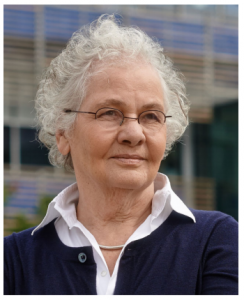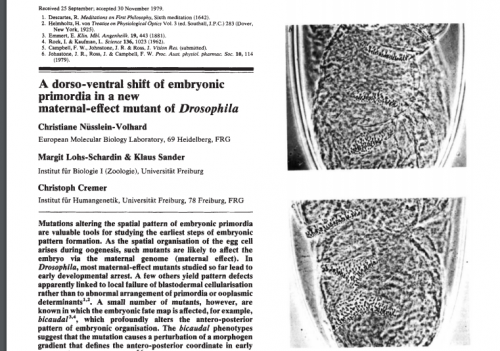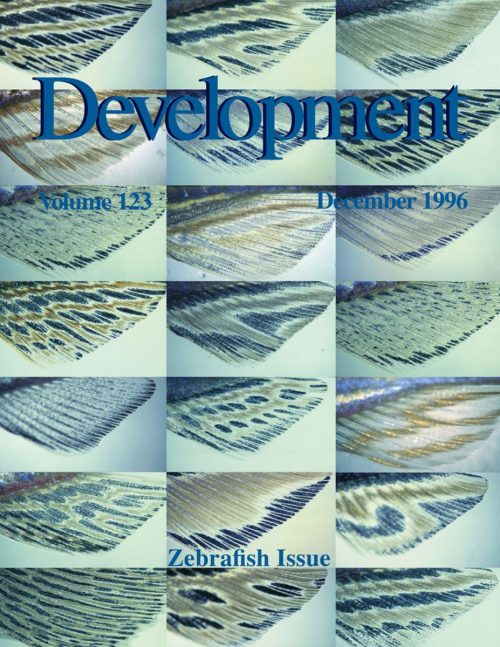An interview with Christiane Nüsslein-Volhard
Posted by the Node, on 3 November 2017
This interview by Katherine Brown originally appeared in Development, Vol 144 Issue 21
Christiane Nüsslein-Volhard is Director Emeritus at the Max Planck Institute for Developmental Biology in Tübingen, Germany. In 1995, she was awarded the Nobel Prize for Physiology and Medicine, along with Eric Wieschaus and Edward Lewis, for her work on the genetic control of embryogenesis using the fruit fly Drosophila melanogaster. In the 1990s, she transitioned her lab to working with zebrafish (Danio rerio), using similar forward genetic approaches to those that had proved so successful in Drosophila to uncover key regulators of vertebrate development. We met with Christiane at the recent International Society for Developmental Biology (ISDB) meeting in Singapore, to talk about her research, the impact of the Nobel Prize and the challenges of being a ‘woman in science’.

Let’s start at the beginning: what got you interested in biology in the first place?
I was interested in animals and plants from very early on. I can’t remember having been taught it as a young child, but I was always curious, even before I went to school. I collected plants from the garden and so on, and I remember that a father of a school friend of mine collected butterflies – with which I was fascinated – and later I also joined a bird-watching club. I still love looking at nature like this – I have a big garden and I’m very interested in gardening and wild flowers. Once I got to secondary school, we had very good science teachers, and of course that helped as well.
Your undergraduate and PhD degrees were in biochemistry and molecular biology, but you’ve said that you started to get bored with that field towards the end of your PhD thesis. What attracted you to developmental genetics and how did you transition into that field?
I actually started my undergraduate studies with biology and I found the lectures rather boring, so I switched to physics, which at the time was fascinating and was taught by a very good professor. I also really enjoyed physical chemistry, and I moved into biochemistry – in which I eventually got my diploma – in order to get a solid background in basic science.
My PhD was in molecular biology, but I’m not a molecular biologist or a biochemist. I went into this area because I was ambitious and at that time it was the field that was really moving forwards and was fashionable. But at the end I found I wanted to do more organismal biology. I think I went into developmental biology at least partly because Alfred Gierer’s group in our institute was working with Hydra, trying to isolate the factors that would specify ‘head’ and so on. Being exposed to this work, I became interested in the question of morphogens. The Gierer-Meinhardt model on morphogen gradients had just been published, and though I didn’t fully understand it, I could see that morphogens were becoming a big issue in the field. However, people were against gradients because they hadn’t been identified.
I thought that to identify morphogens you had to combine genetics and developmental biology: if you could make a mutation in a gene that encoded a gradient and see the consequences of its loss, you would be on the way to finding them. I wrote a proposal for an EMBO fellowship that spelt this idea out, and this was how I ended up in Walter Gehring’s lab working with Drosophila. Gehring kept the strain of the only potential morphogen mutant (identified by Alice Bull in 1966) at the time, which had mirror image duplications of the posterior end that no one understood, although Meinhardt explained to me that it must be a gradient mutant. This was bicaudal, and I tried to understand it but it was the most difficult mutant I ever worked on. So instead I developed methods to make my own mutants and finally ended up at EMBL with Eric Wieschaus, where we started the large-scale screens.
And this is probably the work you’re best known for and that won you and Eric the Nobel Prize – the large-scale genetic screens in Drosophila embryos. Did you think in advance that this work would be so influential?
Looking back, it is amazing how little was known about anything at the time. For example, no one knew anything about how segmentation could work, or about polarity – at least beyond the theoretical work. So it was a completely open area and whatever you touched would turn out to be interesting. For example, in the first half-year in Walter Gehring’s lab I isolated the dorsal mutant, which is a gradient mutant. Lucky me – that was exactly what I’d been looking for! And then we started to find these segmentation mutants – they just popped up when you looked at large numbers of embryos. But strangely enough Eric and I seemed to be the only people who saw the potential in screening for mutants. Somehow, we were far ahead of everyone else – who all thought that screens were too much effort and that they might not work, or that you’d only find ʻmessy’ things.

As I’ve said before, there was also this idea that there were no gradients; many people at the time believed in specific localised determinants rather than gradients. Some groups that did do screens looking for particular kinds of mutants (maternal homeotic mutants) failed completely because they couldn’t interpret the mutants they found – they didn’t fit with their model for how development would work. So when we did our screen, we found things that people had isolated before but hadn’t recognised for what they were.
When we started, we had different research backgrounds and our own interests – I was pushing to do maternal screens to try and get at the morphogens, which was genetically very tricky, while Eric was particularly interested in oogenesis and sex determination. But we had a very small lab with just one technician between us and so we realised it would be better to do things together. So we decided to do the large-scale zygotic screens together, and we were amazingly successful. We were a good team: we had similar observational qualities and were both pushing hard. Three years of collaboration was enough – we were both strong characters – but it worked incredibly well for that time.
One big question was: now we understand something about fly embryogenesis, what about vertebrates? Do they do things the same or completely differently?
And what came out of the screen? Did you uncover genes that play key roles across evolution and did this in some way trigger your starting to work with zebrafish?
Actually, the highlights in the fly screens aren’t conserved at all. In the first evaluation we focussed on segmentation because this is easiest – you can cleanly count the segments and look at polarity and so on. This gave us the pair-rule genes and the gap genes, which were exciting because they told us a lot about an important developmental hierarchy, but these principles aren’t conserved beyond insects. And then when I moved to Tübingen, we did the maternal screens to get the morphogens (which I wanted from the beginning) – we found genes such as bicoid and oskar, but again these are not conserved.
So, one big question was: now we understand something about fly embryogenesis, what about vertebrates? Do they do things the same or completely differently? At the time, the people working with frogs (which were the main system for vertebrate developmental biology back then; the mouse was not that well developed) were a completely separate community from the fly people, and they thought that the fly couldn’t tell them anything. The prevailing view was to explain everything with ‘factors’, and to approach developmental biology through embryological rather than genetic manipulation, while we explained everything with genes and genetics. And I was convinced that the genetic approach was the better one and that you needed to be able to do genetics in vertebrates.
It was only around that time, beginning with the homeobox genes, that the homology between invertebrates and vertebrates slowly became apparent. But we had decided to start a screen in zebrafish before we fully appreciated the degree of conservation, and actually the screen turned up many of the same genes that had already been identified as key factors in frog, so we were perhaps a bit late with this. The biggest question in vertebrate development at the time was how gastrulation works and how the axes are organised, and Eddy De Robertis, Marc Kirschner, Jim Smith and others had already identified things like the critical BMP gradients, so when we identified and cloned the equivalent fish mutants they weren’t a huge surprise.
How difficult was it to transition your lab – which had had such success working with flies – to zebrafish?
Well, by then the fly lab was not that big anymore. My lab style has always been that postdocs took their projects with them, and some of the graduate students too: Ruth Lehmann took oskar and a bunch of mutants with her, and Kathryn Anderson took most of the dorsal group genes. So people had gone away with some of the most interesting projects. When the screens were finished, we began to clone some mutants, which I found tedious and did not like too much, so I decided I wanted to move to fish. However, then the Bicoid gradient was discovered by Hans Georg Frohnhöfer and Wolfgang Driever and the Dorsal gradient by Siegfried Roth (all graduate students in the lab), and we were working very successfully with these projects and the transcription factor hierarchies, and doing lots of biochemistry, and this kept us busy for quite some time. Two graduate students, Stefan Schulte-Merker and Matthias Hammerschmidt, started working with fish on the side during this period, and when the fish screen really got started the fly lab was gradually coming to a natural end.

Setting up a screen in a new organism is a lot of work, but I like this kind of work – developing devices and tools that make things easier and more efficient. This was also the secret of success in the fly screen. It’s maybe my upbringing from home – we used to do handicrafts and make toys and I had quite some dexterity in this sense. Eric is also good at these things, so we invented a bunch of tools and tricks that made life much easier – little things like boxes with a grid for keeping fly stocks (rather than just holding them together with rubber bands as everyone did at the time), and a better system for collecting embryos on agar plates instead having to take them out of the food. And we found a particular type of oil that made embryos transparent so you could look through the chorion, which just made things so much easier and faster for screening.
With the fish it was a similar situation: we needed to be able to make all the processes as efficient as possible to do a large-scale screen. I went to Oregon, where zebrafish were quite well established as a model system, but realised that we couldn’t possibly do a screen with the way they raised fish – it was too laborious. So the first job – and it took two years or so – was to develop better aquarium and feeding systems and so on to streamline everything and allow us to scale up.
Your work now focusses on pigment patterning in adult zebrafish, and in your talk here you introduced the topic as being about the ‘evolution of beauty’, discussing Darwin’s interest in this problem. Did these aesthetic and historic aspects draw you to the problem?
I think the Darwin link came later to be honest. Initially, I was just struck by the beauty of the fish, like I had been by the segmentation pattern of flies: it’s always nicer to work on something you find beautiful. Working with fish, it’s natural to wonder how the pattern is made, and we found a number of mutants with aberrant pigment patterns and started to work on those. To some extent, talking about it in terms of beauty is advertising – it’s a way of explaining why you’re working on this obscure problem. And the more you talk about it the more you think about it, and realise that the stripes must have a function – they must be important. Then I read Darwin’s Descent of Man, which is a fascinating book. He thought about the issue of why humans look different across the world – skin colour, hair colour and so on. At Darwin’s time, some people still thought that black and white people were different species (with the whites superior), and Darwin wondered about this – why are they different, and are they really separate species? He thought that they were too similar to be different species, and he argued that they look different because they have different standards of beauty. He even collected observations from travellers to look for physiological differences (like whether skin colour had a significant effect on heat resistance), but there was no really good biological explanation for why they looked different. So he came up with the idea that it was to do with attractiveness. And when you look around the animal kingdom you see the same thing. The book is partly about sexual dimorphism in the animal kingdom, and beauty is of course very important. When you look at animals like peacocks or birds of paradise, some evolutionary biologists have argued that they grow such extraordinary feathers to prove that they’re strong enough to carry them around, or whatever, and of course that’s rubbish – it’s about beauty. I found this all very interesting, and now use it as a way of explaining why we’re interested in stripes in zebrafish when writing reviews and giving talks.
You’re here in Singapore at the ISDB meeting giving one of the Nobel Prize lectures. You’ve said in the past that winning the Nobel Prize, while a great honour, was a distraction for you scientifically. But it must have given you opportunities you wouldn’t otherwise have had. How do you feel about the prize now?
Yes, I have mixed feelings. When I first won the prize I got carried away – I got invited to give many lectures, some of which I should have said ‘no’ to but didn’t, and in the end I felt sucked dry. Then I was so exhausted that I said ‘no’ quite often, but that was also bad because it spoiled my reputation to some extent. It was just too much and it was hard to focus and to get the balance right. And in the lab, although I generally have very smart students and postdocs who work quite independently, I don’t think I was there enough to give them proper feedback and advice.
You also meet a lot of envy from colleagues, and this is painful sometimes. It has seemed to me that men can have a hard time accepting that women can be smarter, particularly when a woman points out mistakes that the man has made. Throughout my career, I often had difficulties in getting a point across because the men couldn’t bear it that I might ‘win’, and in some cases this got even more difficult after the Nobel Prize.
On the other hand, there were interesting opportunities. For example, I was elected onto the National Ethics Council of Germany. I had to learn a huge amount for this – for example, about mammalian embryology and stem cells – and this took a lot of time. It was very interesting but, to be honest, it was not fun. There was so much dispute about how to handle some of these issues, and many people were very old-fashioned and even hostile in some cases. And I lost most of the fights – I was on the liberal side and unfortunately the conservative side usually won. But it was a very interesting experience and I wouldn’t have missed it. And of course you also have the opportunity to get in contact with really interesting people through membership of learned societies and academies, and this has been a real reward.
You must have been one of only a very few women around when you started in research, and you’ve talked about how difficult you found this. How do you think the situation for women has changed over the years?
It’s much better now, though I think we’re overshooting a bit in some areas – search committees run after women in some cases, and that’s another danger – but still have discrimination in other situations. So things aren’t yet where they should be.
But, more broadly, science has also changed: it’s more competitive now with many more scientists and more bad science than there used to be, and it’s difficult to survive with an honest and ethical approach to science. I don’t think we’re in a good place at the moment: it’s so hard for people to find jobs, and most scientists don’t have permanent contracts. This means that people are forced to advertise and even exaggerate the impact of their work, and waste so much time applying for money – the funding rate is so low. I didn’t have an easy time either when I was struggling to get a job in the early days – what Eric and I were doing was seen as quite obscure – but it’s so much more difficult today. I find it quite ambiguous to talk people into doing science nowadays because I don’t necessarily see it as a very nice or easy job.
The important thing with the CNV Foundation is to teach women that it’s okay to let people help you because you can’t do everything yourself
In 2004 you set up the CNV-Stiftung, a foundation that supports women in science with children. What drove you to set up the foundation, and what has it achieved?
I have been on committees about women in science since before I was appointed as a Max Planck Director, and after my appointment I was just one of two women directors in the whole society. As I’ve said, it was very difficult at the time and I felt very awkward. People come up with all sorts of ideas to encourage women in science, and I thought that money is perhaps something that would really help. Women usually do the bulk of the housework and they often don’t think it’s okay to ask for help from outside – it took me years to decide to get a cleaner. In general, I find that men either get this stuff done by their wives or they hire someone, but women are more reluctant. So I thought it would be good to give women money to allow them to have an easier life around the house. The important thing with the CNV Foundation is to teach women that it’s okay to let people help you because you can’t do everything yourself and you need to have some free time. We support around 15 women working in Germany per year: we started out just funding students with children, because they really don’t have the money, but now we also support postdocs. But the problem of women in science is very complicated, and while I think our foundation helps, it clearly doesn’t solve things.
Do you have any advice for young scientists?
You really need to be genuinely interested in science and enjoy making discoveries. The job depends on achievements: making discoveries and publishing them. This means hard work, and if you are not rewarded by success it can be very frustrating. You should, as far as possible, avoid mainstream areas and change fields after your PhD in order to be able to develop an independent profile and work on an original, self-selected topic. Don’t listen too much to mentors and teachers: they may not be honest but just polite. So it is important to self-critically assess your own abilities in comparison with others. It is your own responsibility.
Finally, what might readers of Development be surprised to find out about you?
I wrote a cook book, in German, which was published in 2006. I love to cook, and I think there are similarities with working in a lab: the organisation, the working with your hands and so on. I didn’t do so much cooking when I actually worked in the lab (though I used to take a cake to the lab every weekend), but when I stopped doing things with my hands at work I started cooking and baking again, and I wrote this book. It is still on the market!

And I love music – I play the flute and sing. I have taken lessons for the last ten years and love to sing German Kunstlieder, and I sometimes give concerts to my friends.


 (1 votes)
(1 votes)